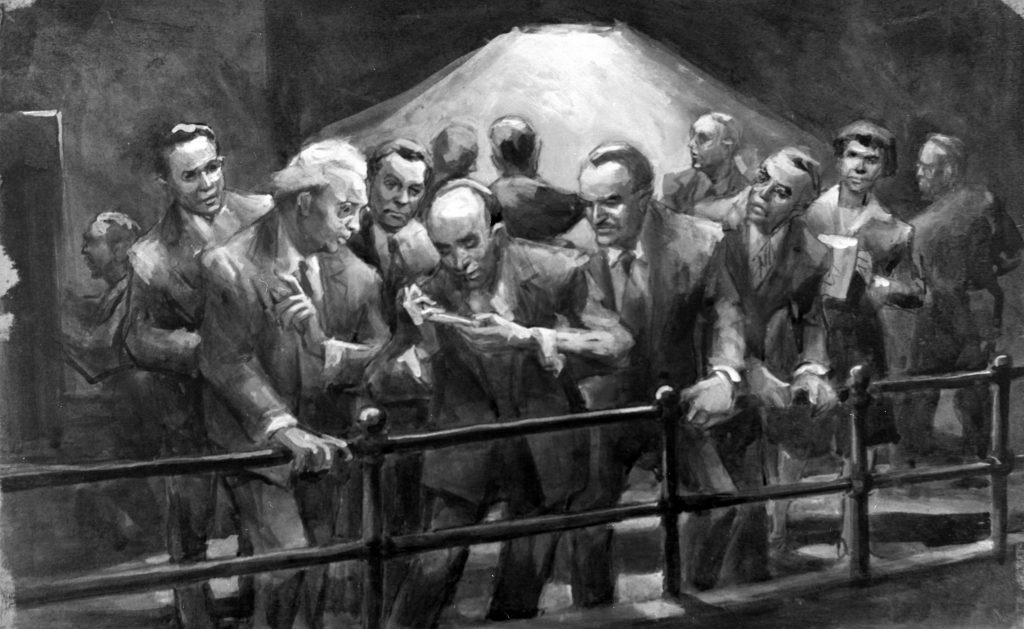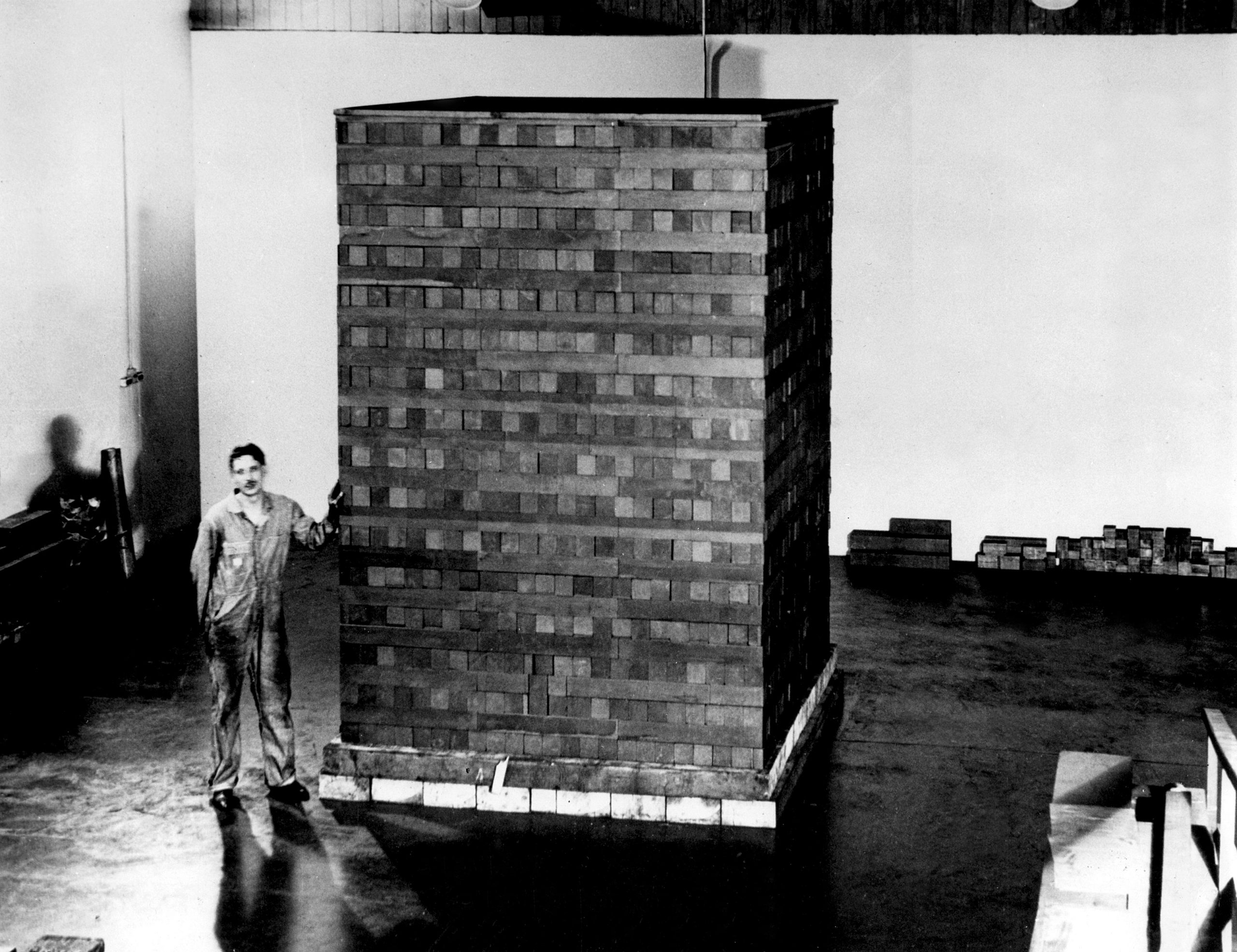One of the most important branches of the Manhattan Project was the Metallurgical Laboratory at the University of Chicago. Known simply as the “Met Lab,” the laboratory’s primary role was to design a viable method for plutonium production. Starting in 1939, a team of scientists, including Enrico Fermi, Leo Szilard, Walter Zinn, and Herbert Anderson, conducted experiments at Columbia University using chain-reacting nuclear “piles” to measure the neutron emission from fission. Production was moved to the Met Lab in February 1942 with the goal to produce a self-sustaining nuclear reaction. This experimental proof could then serve as a model for large-scale plutonium production.
Construction
An abandoned rackets court underneath Stagg Field in the middle of the University of Chicago campus was chosen as the test site for the experiment. It was selected after reassurances from Fermi that the probability of an accident was minimal. Nevertheless, the scientists could not be sure they could control the reaction. When asked what he would do if anything went wrong, Fermi replied, “I will walk away – leisurely” (Rhodes 436).
In the freezing cold, workers and scientists built the pile by stacking layers of graphite bricks on top of a crude wood framing. The bars had to be cut exactly to fit closely together. Some were drilled with holes to fit lumps of uranium inside, and were alternated with regular “dead uranium” graphite bricks. Others were drilled to fit 14-foot cadmium “control rods” which, when removed, would cause the reaction to go critical.
Construction was finished on December 1, 1942. 771,000 pounds of graphite were used to build 57 layers. The pile also used 80,590 pounds of uranium oxide and 12,400 pounds of uranium metal, approximately $1 million worth of materials.
Going Critical
On December 2, 1942, Fermi and the other scientists watched from a balcony while the last scientist on the floor, George Weil, methodically pulled out the cadmium rods as instructed by Fermi. The cadmium rods absorbed neutrons and acted as a brake on the nuclear reaction. Using Geiger counters, the scientists closely monitored the value k of the reaction, the effective neutron multiplication factor, which is the average number of neutrons from fission that will cause another reaction. A high enough measurement would indicate that the reaction could sustain itself.
 After a break for lunch, Fermi ordered Weil to pull the final cadmium rod out of the pile another 12 inches. Fermi told Arthur Holly Compton, “This is going to do it. Now it will become self-sustaining.” (Rhodes 439) Sure enough, the pile went critical, creating the world’s first self-sustaining chain reaction. It demonstrated a k value of 1.0006, and was allowed to reach a thermal output of 0.5 watts (ultimately it operated at 200 watts maximum). Physicist Herbert Anderson recalled:
After a break for lunch, Fermi ordered Weil to pull the final cadmium rod out of the pile another 12 inches. Fermi told Arthur Holly Compton, “This is going to do it. Now it will become self-sustaining.” (Rhodes 439) Sure enough, the pile went critical, creating the world’s first self-sustaining chain reaction. It demonstrated a k value of 1.0006, and was allowed to reach a thermal output of 0.5 watts (ultimately it operated at 200 watts maximum). Physicist Herbert Anderson recalled:
At first you could hear the sound of the neutron counter, clickety-clack, clickety-clack. Then the clicks came more and more rapidly, and after a while they began to merge into a roar; the counter couldn’t follow anymore. That was the moment to switch to the chart recorder. But when the switch was made, everyone watched in the sudden silence the mounting deflection of the recorder’s pen. It was an awesome silence. Everyone realized the significance of that switch; we were in the high intensity regime and the counters were unable to cope with the situation anymore. Again and again, the scale of the recorder had to be changed to accommodate the neutron intensity which was increasing more and more rapidly. Suddenly Fermi raised his hand. “The pile has gone critical,” he announced. No one present had any doubt about it (Rhodes 440).
After less than 5 minutes, Fermi ordered that the reactor be shut off. Eugene Wigner broke out a bottle of Bertolli Chianti he had been saving for the celebration. The scientists drank it out of paper cups and afterwards they all signed the straw wrapping on the bottle. Forty-nine scientists and workers witnessed the historic event. For a list of those present, please click here.
A few hours later, Arthur Compton, the director of the Met Lab, called his boss at Harvard, James Conant. “Jim, you’ll be interested to know that the Italian navigator has just landed in the New World,” he said.
“Were the natives friendly?” asked Conant.
“Everyone landed safe and happy,” Compton replied (Rhodes 442).
Legacy
The Chicago Pile-1 Reactor was soon disassembled and rebuilt with concrete radiation-protecting shielding at the nearby Argonne Laboratory as Chicago Pile-2. The experiment not only proved that nuclear energy could generate power, but also showed a viable method to produce plutonium. Large -scale reactors, including the X-10 Graphite Reactor at Oak Ridge and the B Reactor at Hanford, were subsequently built with Chicago Pile-1 as a model.
Although Stagg Field would be demolished in 1957, a plaque commemorating Chicago Pile-1 was dedicated for its 5th anniversary. The plaque, which remains there to this day, reads, “On December 2, 1942, man achieved here the first self-sustaining chain reaction and thereby initiated the controlled use of nuclear energy.”
For the 25th anniversary in 1967, British sculptor Henry Moore erected a bronze sculpture on the site of Stagg Field titled “Nuclear Energy.” Moore commented, “Like anything that is powerful, it has a power for good and evil… the lower part [of the sculpture] is more architectural and in my mind has the kind of interior of a cathedral with sort of a hopefulness for mankind.” Today, the site of Chicago Pile-1 is a Chicago Landmark and a National Historic Landmark.





